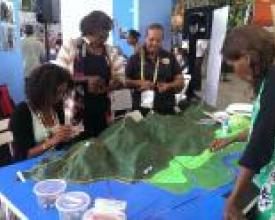Empowering Mandingalbay Yidinji people through P3DM

Mandingalbay Yidinji (MY) people from the Wet Tropics World Heritage Area, Australia, have used Participatory 3 Dimensional Modelling (P3DM) to empower their community through the mapping and sharing of cultural and landscape knowledge. The project was facilitated by Wet Tropics Management Authority, and involved all of the MY community. Decision making about what to show, and what to exclude, was made entirely by the MY people.
Context
Challenges addressed
loss of cultural information in protected areas Much vital cultural information in protected areas is lost when knowledge holders die, are disconnected and/or when they cannot access key cultural sites. Many methods of mapping culturally sensitive information are untrusted and overly technical. P3DM empowers indigenous people as the drivers of the process.
Location
Process
Summary of the process
A P3DM is the outcome of a well facilitated process with true participation at its core. Each building block relies on a solid foundation created during the previous building blocks. The facilitator's ability to keep participants involved and on task provided the glue for continuity, and built trust of the facilitator by participants. Construction of the model 'to scale' invited questions and curiosity, which in turn generated continued interest and an ownership of the 'community built' product. Participants commitment to the project deepened at each successive stage of involvement and as they 'experienced' the value of the process. P3DM is not only about mapping knowledge, it has been used all over the world for protected area planning, climate change impact, conflict resolution, resource mapping, wildlife management, recording intangible heritage etc. The empowerment of the Mandingalbay Yidinji people through P3DM will instill in them a new confidence to be the agents of change within their own environments.
Building Blocks
Community identification and selection
Enabling factors
Lesson learned
Community briefing and site selection
Enabling factors
Lesson learned
Technical and GIS preparation
Enabling factors
Lesson learned
Creating and agreeing on the model legend/key
Enabling factors
Lesson learned
Constructing the model
Enabling factors
Lesson learned
Depiction of knowledge on to model
Enabling factors
Lesson learned
Impacts
The P3DM project undertaken in October 2014, has already yielded impacts and change. An MY community member was heard to say "..doing this has reconnected me back to my country, my landscape, I didn't expect that...". This project bought community together to focus on something positive, and to be in a process where MY people could control the outcomes - a rare occurrence for Australian indigenous peoples. The P3DM process has also started reconnecting young people who have become disconnected from culture and the landscape -they have become interested in what older community members have to say, and started to see how much cultural knowledge remains within MY elders.
The P3DM project has already encouraged MY people to use the model for planning economic development activities on their traditional lands to create more sustainable livelihoods. Another impact is the inspiration this project has created in other Aboriginal people to learn about and use P3DM themselves. Ideally MY people will be at the front of facilitating future P3DM activities with other Aboriginal communities. This will help to broaden, strengthen and deepen impact.
Beneficiaries
Mandingalbay Yidinji Aboriginal people and Wet Tropics Management Authority.
Sustainable Development Goals
Story
In November 2014 six Mandingalbay Yidinji representatives participated in the the 6th World Parks Congress in Sydney, Australia. During the construction phase community developed an extra 2m x 1m 'blank' that was transported by road to Sydney. MY representatives spent 3-4 days doing a live demonstration at the Congress slowly depicting their knowledge using paint, pins and wool strands, on to the blank. In addition to cultural heritage information, they also mapped boundaries such as the Wet Tropics World Heritage Area, and the Mandingalbay Yidinji Indigenous Protected Area. This live demonstration, held at the WIN and Pacific Communities Pavilion, attracted much attention and genuine interest from delegates from all over the world. The work being done by MY people created an exciting buzz around the Pavillion and drew people in to ask questions about the process and about MY traditional country. Over 250 delegates left their business cards at the demonstration seeking more information about P3DM! The demonstration was part of a wider Congress series on P3DM coordinated by the Technical Centre for Agricultural and Rural Cooperation (CTA). CTA also coordinated the attendance of P3DM practitioners from Kenya, Chad, Suriname, Samoa, Ethiopia, Trinidad and PNG. Meeting and sharing experiences with other Indigenous P3DM practitioners, and conversing with delegates from all over the world assisted MY people to understand the importance of their own experience in a global context. The WPC experience increased MY delegates confidence and their belief in P3DM as a very valuable technique. In a Congress session on the risks and benefits of mapping traditional knowledge, MY people presented the completed model back to the Congress and spoke about their experiences during the process and as Rainforest Aboriginal people. Congress Champion Mr Luvuyo Mandela attended the presentation and in a moving speech said "we, as Indigenous people need to learn a language that helps us communicate what we need and who we are in a way that’s digestible to the rest of the community. This initiative is an incredible one."



